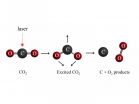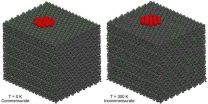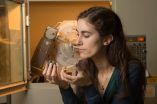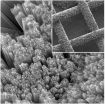Satellite animation shows formation of Tropical Storm Simon off Mexico's southwestern coast
2014-10-03
(Press-News.org) VIDEO:
Mexico's western coast is again dealing with rain, wind and rough surf from another tropical storm. NOAA's GOES-West satellite saw the formation of Tropical Storm Simon on Oct. 2. A...
Click here for more information.
Mexico's western coast is again dealing with rain, wind and rough surf from another tropical storm. NOAA's GOES-West satellite saw the formation of Tropical Storm Simon on Oct. 2. A NASA animation of NOAA's GOES-West satellite imagery shows the development of Simon over three days.
Simon developed when the tropical low pressure area designated as System 90E organized by 5 p.m. EDT on Oct. 1 and became Tropical Depression 19-E. On Oct. 2 at 5 a.m. EDT, the depression strengthened into a tropical storm as was renamed "Simon." An animation of three days' worth of visible and infrared images created by the NASA/NOAA GOES Project at NASA's Goddard Space Flight Center in Greenbelt, Maryland showed those transitions.
Simon is the eighteenth named storm of the busy 2014 hurricane season in the east Pacific basin.
NOAA's GOES-West satellite has been providing continual coverage of the Eastern Pacific and has followed the development of Simon since it was System 90E. An infrared GOES-West satellite image taken on Oct. 2 at 13:15 UTC (9:15 a.m. EDT) showed Simon close to the western coast of Mexico.
The National Hurricane Center (NHC) noted on Oct. 2 that satellite images show curved bands of thunderstorms) became better established during the morning hours on Oct. 2, and the low-level center is estimated to be located beneath the strong thunderstorm activity.
NHC has not posted watches or warnings on Simon, but the tropical storm is large and close enough to shore to generate some heavy rainfall totals and rough surf.
Simon is expected to produce rainfall amounts of 3 to 5 inches with isolated amounts around 8 inches through Friday, Oct. 3 across Western Guerrero and Michoacan, Colima, western Jalisco and Nayarit in western Mexico. These rains could cause flash flooding and mud slides.
Simon is generating ocean swells and rough surf that is already affecting southwestern Mexico's coast. These swells are likely to cause life-threatening surf and rip current conditions.
At 5 a.m. EDT Simon had maximum sustained winds near 40 mph (65 kph) and some strengthening is forecast during the next two days. Simon's center was located near latitude 18.1 north and longitude 106.1 west. That's about 135 miles (215 km) west-southwest of Manzanillo, Mexico and Simon was moving toward the west-northwest near 10 mph (17 kph) and is expected to continue through Oct. 3. Simon's center is expected gradually move away from the southwestern coast of Mexico today.
The NHC's Forecaster Cangialosi noted that Simon is expected to strengthen during the next few days while the storm remains over warm water and within a fairly low wind shear and moist environment. Conditions will change in three days when the storm is expected to start on a weakening trend.
INFORMATION:
[Attachments] See images for this press release:
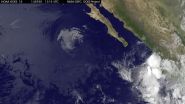
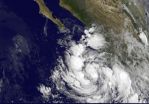
ELSE PRESS RELEASES FROM THIS DATE:
2014-10-03
About one-fifth of the Earth's atmosphere is oxygen, pumped out by green plants as a result of photosynthesis and used by most living things on the planet to keep our metabolisms running. But before the first photosynthesizing organisms appeared about 2.4 billion years ago, the atmosphere likely contained mostly carbon dioxide, as is the case today on Mars and Venus.
Over the past 40 years, researchers have thought that there must have been a small amount of oxygen in the early atmosphere. Where did this abiotic ("non-life") oxygen come from? Oxygen reacts quite aggressively ...
2014-10-03
Curiosity helps us learn about a topic, and being in a curious state also helps the brain memorize unrelated information, according to researchers at the UC Davis Center for Neuroscience. Work published Oct. 2 in the journal Neuron provides insight into how piquing our curiosity changes our brains, and could help scientists find ways to enhance overall learning and memory in both healthy individuals and those with neurological conditions.
"Our findings potentially have far-reaching implications for the public because they reveal insights into how a form of intrinsic motivation ...
2014-10-03
White Americans may view diversity and multiculturalism more negatively as the U.S. moves toward becoming a minority-majority nation, UCLA psychologists report.
As part of their study, the researchers divided 98 white Americans from all regions of the country — half male, half female, with an average age of 37 — randomly into two groups. One group was told that whites will no longer be the majority in the U.S. by 2050; in fact, this is likely to be true as soon as 2043, according to some projections. The second group was told that whites would retain their majority status ...
2014-10-03
BELLINGHAM, Washington, USA -- New applications of structures and materials that replicate complex yet efficient arrangements that have evolved in nature over millennia are featured in a special section on biomimetic and bioinspired materials for applications in biophotonics in the October issue of the Journal of Biomedical Optics. The journal is published by SPIE, the international society for optics and photonics, in the SPIE Digital Library. Several of the peer-reviewed articles are accessible via open access.
"Biomimetic and bioinspired materials present an emerging ...
2014-10-03
VIDEO:
The video compares the two sliding states of the C60 flake attached to the tip of the microscope: a) commensurate state at low temperature where the C60 do not rotate...
Click here for more information.
About 3500 years ago, man invented the wheel to make life easier. Then, thanks to Leonardo Da Vinci's genius, the wheel was made smaller to obtain ball bearings. And today? "Today we are trying to get even smaller: scientists are thinking about nano-bearings", comments ...
2014-10-03
PULLMAN, Wash.—A Washington State University undergraduate has helped develop a new method for detecting water on Mars. Her findings appear in Nature Communications, one of the most influential general science journals.
Kellie Wall, 21, of Port Orchard, Wash., looked for evidence that water influenced crystal formation in basalt, the dark volcanic rock that covers most of eastern Washington and Oregon. She then compared this with volcanic rock observations made by the rover Curiosity on Mars' Gale Crater.
"This is really cool because it could potentially be useful for ...
2014-10-03
COLUMBUS, Ohio—Is it a solar cell? Or a rechargeable battery?
Actually, the patent-pending device invented at The Ohio State University is both: the world's first solar battery.
In the October 3, 2014 issue of the journal Nature Communications, the researchers report that they've succeeded in combining a battery and a solar cell into one hybrid device.
Key to the innovation is a mesh solar panel, which allows air to enter the battery, and a special process for transferring electrons between the solar panel and the battery electrode. Inside the device, light and oxygen ...
2014-10-03
Too many stroke patients in Canada are not getting the rehabilitation they need to return to a healthy, active life, according to a new study which will be presented at the Canadian Stroke Congress in Vancouver tomorrow. The research findings strongly suggest that such decisions are being made based on what services are available in the health system rather than what patients really need.
It found that overall just 16 per cent of patients with stroke were discharged to inpatient rehabilitation but that the rates varied widely by province (1% to 26%) and hospital (0% to ...
2014-10-03
They base their findings on 1221 Danish men between the ages of 18 and 28, all of whom underwent a medical examination to assess their fitness for military service, which is compulsory in Denmark, between 2008 and 2012.
As part of their assessment, the military recruits were asked how much alcohol they drank in the week before their medical exam (recent drinking); whether this was typical (habitual); and how often they binge drank, defined as more than 5 units in one sitting, and had been drunk in the preceding month.
They were also invited to provide a semen sample ...
2014-10-03
There is some evidence to suggest that alcohol impairs the workings of the immune system, both in terms of the initial protective inflammatory response to infection and the development of subsequent immunity.
And habitual drinking is known to increase susceptibility to bacterial pneumonia, septicaemia, tuberculosis and viral hepatitis. The researchers therefore wanted to find out if there was any association between drinking patterns and susceptibility to HPV infection.
They included 1313 men who were already taking part in the US arm of the HPV in Men (HIM) study, ...
LAST 30 PRESS RELEASES:
[Press-News.org] Satellite animation shows formation of Tropical Storm Simon off Mexico's southwestern coast


